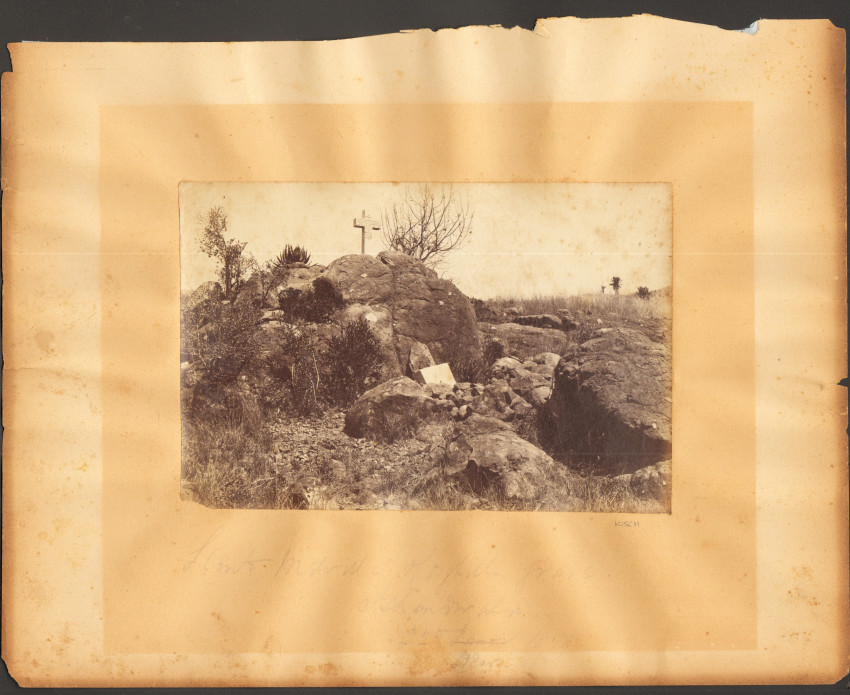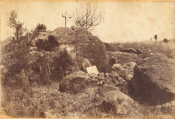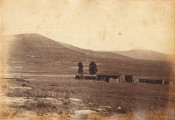Each 130 x 200 mm, mounted on loose album leaves, some with pencil captions beneath the images. The leaves are browned and friable. The photographs are in good condition. Most date from 1879 – 1881.
- Bushman’s Pass War GWRN [?] 1877: Depicts a group of British servicemen, possibly Royal Navy (original caption is unclear) accompanied by African auxilliary troops at the Bushman’s River Pass in the Drakensberg Mountains. The site is now known as Langalibalele Pass, in honour of the Hlubi chief whose men fought there against Natal Carbineers and Natal Native Police commanded by Major A. W. Durnford on 4 November 1873. The engagement was considered a significant precursor to the British invasion of Zululand in 1879, though the purpose of the visit depicted in this photograph is unknown.
- Durban from the Berea 1879: Depicts the port and major settlement of colonial Natal, where substantial numbers of British troops landed for the second invasion of the Zulu kingdom on 7 March 1879. The photographs of sites associated with the coastal campaign of the second invasion were taken during March and April of 1879, although this image may date from earlier as the photographer was based in Durban.
- Stores [?] formed on the Lower Tugela River, Zulu War 1879: Depicts supplies gathered for the coastal column commanded by Maj-Gen. H. H. Crealock during the second invasion. The site on the southern bank of the Tugela River, in Natal, was named Fort Pearson in honour of the British commander of the forces besieged by the Zulu army at Eshowe since January of 1879. The photograph was most likely taken in April 1879.
- Bridge of ponts across the Lower Tugela from Natal side to the Zulu border, April 1879: Depicts the temporary crossing constructed by the Royal Engineers and Naval Brigade to convey troops and supplies across the Tugela River, which formed the boundary between colonial Natal and the Zulu kingdom in 1879. The “Ultimatum Tree” where British demands were delivered to representatives of the Zulu kingdom on 11 December 1878 during the lead up to hostilities is located nearby, out of sight to the right of where this photograph was taken.
- Wagons crossing Nyezan Drift to relief of Eshowe, 1879: Depicts forces of Maj-Gen. H. H. Crealock’s coastal column crossing the Nyezane River en route to Eshowe during the second invasion of Zululand in April or May 1879. The siege of Eshowe was relieved by Lord Chelmsford on 3 April 1879, following the battle of Gingindlovu the previous day, but the wagons were not taken up the steep road at that time and this image more likely shows troops moving into Zululand after 21 April when the second invasion was under way.
- Marines and Blue Jackets Camp - Fort Chelmsford, Zulu War 1879: Depicts Royal Marines and naval ratings (Bluejackets) behind defensive earthworks at the second of Maj-Gen. H. H. Crealock’s fortified positions built during the second invasion, and named in honour of the overall commander Lord Chelmsford. Situated about 6km northeast of the battlefield of Gingindlovu (2 April 1879), it was constructed in May 1879 as a staging post for supplies and guarded a ford or “drift” on the road across the Nyezane River. A memorial for the soldiers and sailors who died during their occupation of Fort Chelmsford marks the site.
- Isandhlwana Hill: Depicts the sandstone outcrop that gives its name to the battle of Isandlwana, fought on 22 January 1879, when a force of 20 000 Zulu warriors under the command of Chief Ndlela kaSompisi destroyed the British camp of the central column of the first invasion. Approximately 1770 British and colonial troops under the immediate command of Maj. H. B. Pulleine lost their lives in fighting near the hill, while it is estimated that around 2000 Zulus died as well.
- Rorke’s Drift & grave yard - defended 22 January December 1879: Depicts the remains of the former mission house at Rorke’s Drift, which was used as a hospital before and during the battle of Rorke’s Drift on 22 January 1879, and burned by the Zulus during the night of the engagement. To the left of the structure is the small walled cemetery containing the remains of 17 soldiers of the 24th Regiment who died either during the defence, or later from their wounds. The stone wall and memorial obelisk was erected soon after the engagement, under the supervision of a former stonemason Pvt. Mellsop 2/24th, and appeared in an Illustrated London News engraving of 14 June 1879.
- Lieuts. Melville & Coghill’s grave - Isandhlwana 22 January Dcmbr 1879: Depicts the stone cross and grave cairn of Lt. Teignmouth Melvill and Lt. Nevill Coghill on the slope above Fugitives’ Drift on the Natal bank of the Buffalo River, about 7km southwest of Isandlwana. The two officers’ remains were buried where they were found by a burial party on 3 February 1879, although the cross was erected later during the year. The account of their combined attempt to save the Queens Colour of the 24th Regiment after the battle of Isandlwana, and subsequently each other's lives at Fugitives’ Drift, resulted in the posthumous award of the Victoria Cross to both men in 1907.
- Field of Isandhlwana - January Decmber 1879: Depicts an alternate view of the grave and cross of Lieutenants Melvill and Coghill at Fugitives’ Drift, above the Buffalo River, about 7km southwest of Isandlwana battlefield.
- Women of Cetewayo’s kraal: Depicts unidentified women of the Zulu royal isigodlo or private household, second half of 1879. Although some of the women in this image may actually have been wives of King Cetshwayo kaMpande, it is more likely that these are female attendants of the king and other high-ranking members of the Zulu court. In 1879 the isigodlo was comprised of a wide variety of women, including King Cetshwayo’s wives and other close female family members, as well as the daughters of many chiefly families who were placed under his direct authority to be married to other notable families at his discretion. In addition though, the isigodlo also contained significant numbers of attendants, most of whom were commoners by birth or originally even entered service as captives of war, and saw to the personal needs of the royal family.The photograph was taken after the conclusion of hostilities in July 1879.
- Women of King Cetewayo’s kraal: Depicts unidentified women of the Zulu royal isigodlo or private household, second half of 1879. Although some of the women in this image may actually have been wives of King Cetshwayo kaMpande, it is more likely that these are female attendants of the king and other high-ranking members of the Zulu court. In 1879 the isigodlo was comprised of a wide variety of women, including King Cetshwayo’s wives and other close female family members, as well as the daughters of many chiefly families who were placed under his direct authority to be married to other notable families at his discretion. In addition though, the isigodlo also contained significant numbers of attendants, most of whom were commoners by birth or originally even entered service as captives of war, and saw to the personal needs of the royal family. The photograph was taken after the conclusion of hostilities in July 1879.
- Daughters of a Zulu chieftain: Depicts unidentified young women who may have been either family members or attendants in the household of figure of authority within the Zulu kingdom. This photograph could possibly have been taken during the second invasion of Zululand between April and July 1879 as various leaders of the kingdom abandoned King Cetshwayo kaMpande and offered allegiance to the British.
- Natal Kaffirs: Depicts an unidentified group of young women from colonial Natal with freshly harvested pumpkins known as izinthanga. The period when the photograph was taken is unknown.
- Fort Harrison at St John’s River - Pondoland, built by 3/60th Rifles in 1880: Depicts the temporary fortification built at what later became the settlement of Port St Johns on the mouth of the Mzimvubu River. Pondoland was later annexed to the Cape Colony in 1884 and the fortification was abandoned.
- Amajuba Hill, March 1881: Depicts the mountain battle site between Newcastle and Volksrust where a British force of 405 troops under the command of Gen. Sir George Colley was defeated by a similar number of Boers led by Gen. Piet Joubert on 27 February 1881. With the photographer's wagon in the foreground.
With thanks to Steve Kotze for his valuable assistance in identifying these images.
- Sold By: Clarke's Africana & Rare Books
- Contact Person: Paul Mills
- Country: South Africa
- Email: [email protected]
- Telephone: 021 794 0600
- Preferred Payment Methods: Visa & Mastercard via PayGate secure links and Bank transfers.
- Trade Associations: ABA - ILAB, SABDA
























































